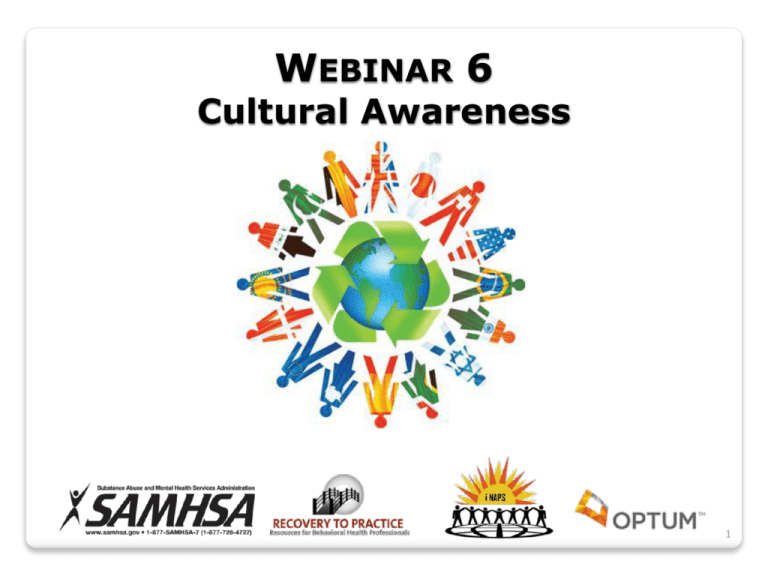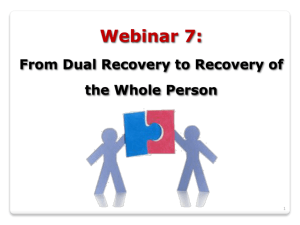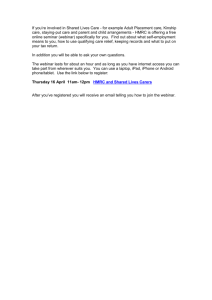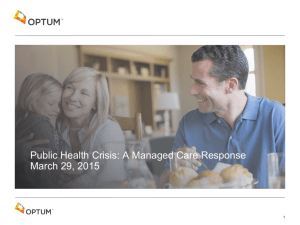Culture What is….
advertisement

WEBINAR 6 Cultural Awareness 1 Welcome to the sixth in a series of webinars for peer supporters drawn from the Recovery to Practice (RTP) project, a SAMHSA-funded project to foster recoveryoriented practice in behavioral health professions. This webinar series is presented by members of the International Association of Peer Supporters (iNAPS) with generous assistance of Optum, without whom this series would not be possible. iNAPS is solely responsible for the content of the webinars. The webinar will begin at noon, Eastern. Thank you for your participation! PLEASE NOTE: These webinars will be recorded and be made available on our website for future viewing. As a participant in the webinar, your name, voice and any interactions you have in the Q and A session may be included in the recording.. Thank you for your participation! WEBINAR 6 Cultural Awareness 5 Denise Camp WRAP Outreach Coordinator / Training Specialist On Our Own of Maryland denisec@onourownmd.org 410-646-0262 Peter Ashenden Director of Consumer Affairs OptumHealth Behavioral Solutions Contact Information T +1 612-632-2963 F +1 877-309-8548 Peter.ashenden@optum.com www.optum.com WEBINAR 6 Cultural Awareness 8 Objectives For you to be able to: Define culture and give examples of components Explain cultural identity Identify different cultural influences on recovery Demonstrate why cultural sensitivity is especially important for peer specialists 9 What is…. “We don’t see things as they are; we see things as we are” ~~Anais Nin What is culture? Age Race Ethnicity Language Gender Sexual orientation Physical illness or disability Class / socioeconomic status What are sub-cultures? Veteran culture Army Navy Air Force Marine National Guard / Reserves Officers Enlisted Active duty Retired Combat veterans Non-combat What’s My Cultural Identity? Age Race Ethnicity Language Gender Sexual orientation Physical illness or disability Class / socioeconomic status Education Cultural Competency Adapted from Terry Cross (1989) Cultural Competency Adapted from Terry Cross (1989) HOW CULTURALLY COMPETENT WAS/IS 1. The first place you received services? 2. The place where you shop for groceries? 3. The place where you receive services now? 4. The place where you get your hair done? 5. Your faith community? 6. The peer support services that you provide? What is Diversity? What are the Barriers? Trauma and Culture Cultural Humility Cultural Humility with Non-Peer Co-Workers Cultural Broker A cultural broker is a go-between, one who advocates on behalf of another individual or group ~~ Jezewki & Sotnik Cultural Broker Roles Liaison Cultural guide Mediator Catalyst for change Addressing Cultural Barriers 1. Volunteer recorder 2. Pick a cultural group 3. Identify sub-cultures 4. List cultural barriers 5. Identify peer support approaches / solutions 6. Report to the large group Reference: Appendix A – Community Integration Tool: Cultural Competence in Mental Health Summary Are you able to: Define culture and give examples of components? Explain cultural identity? Identify different cultural influences on recovery? Demonstrate why cultural sensitivity is especially important for peer specialists? 29 Recovery to Practice Links Overall Project www.samhsa.gov/recoverytopractice Resource Library www.dsgonline.com/rtp/resources.html Peer Specialist Discipline www.naops.org www.rtp4ps.org ? ? ? Questions…. To unmute your line, press *6. To mute your line again, press *6 Overall RTP Project www.samhsa.gov/recoverytopractice Resource Library www.dsgonline.com/rtp/resources.html Peer Supporter Discipline www.naops.org link to www.rtp4ps.org Wounded Healer Video http://www.youtube.com/watch?v=orxEawi9qro E-mail: webinars@naops.org Denise Camp WRAP Outreach Training Coordinator On Our Own of Maryland 410.646.0262 x25 denisec@onourownmd.org From Dual to Recovery of the Whole Person October 2013 Date tbd Go to our website: www.naops.org for up-to-date information









